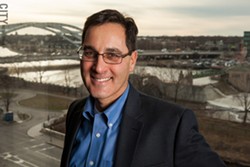[
{
"name": "500x250 Ad",
"insertPoint": "5",
"component": "15667920",
"parentWrapperClass": "",
"requiredCountToDisplay": "1"
}
]
Kate (last name withheld, at her request) says that she doesn't remember much about the morning of August 28, 2013. A Newark resident, she got up that morning as usual to prepare for her job as a recreation therapist in the dementia unit at the DeMay Living Center. Her family says that she complained of extreme chest pain, and then someone called her doctor.
"We got in the car and started to go, and by three minutes out, I was gone," she says. They raced to Newark-Wayne Community Hospital, where an EMT got her breathing again, Kate says in a video promotion she did for the Rochester Regional Health System (the new name for the merged Rochester General and Unity Health systems).
The staff at Newark-Wayne recognized the seriousness of her condition, Kate says, and quickly loaded her on a helicopter bound for Rochester General Hospital, where physicians had already reviewed her records electronically and wasted no time discovering that the artery on the front of her heart was completely blocked. They performed surgery to open the artery and then used a hypothermia protocol to cool her down and allow her brain to recover.
This kind of partnership between an urban and rural hospital, along with the real-time online information-sharing now available to health care systems, allowed the doctors to save Kate's heart — and her brain — using technology that no small rural hospital could afford on its own.
Kate's story helps contextualize the RGH-Unity merger. The trend toward large health care systems — which actually began years ago — has accelerated in response to incentives built into the federal Affordable Care Act, but also thanks to state regulations and increasing pressure for better outcomes and lower costs from business and commercial insurers.
"The days of smaller, independent, stand-alone hospitals are gone," says Nancy Adams, executive director of the Monroe County Medical Society.
The new health care system will rely much less on expensive inpatient care and more on outpatient services and preventive care. To survive and to maintain their capacity for state-of-the-art surgical care, hospitals must broaden their patient population bases (bringing outlying hospitals like Newark-Wayne under the umbrella of a regional system) and generate additional revenue by incorporating non-hospital-based care into their networks.
This approach, called "vertical integration," brings a wide range of physician practices, ambulatory care facilities, mental health and drug treatment programs, home care services, and even senior housing under one corporate umbrella. In fact, 60 percent of the physicians in Monroe County are employed by a health care system today, Adams says, and that percentage could grow over time.
"We have a dramatic change in the payer system, both insurers and federal payers," she says. "We are moving from a fee-for-service model to a quality-based system." That is, a system that pays for healthy outcomes, not for each aspirin tablet, saline drip, pair of surgical gloves, or CT scan.
In this new model for health care, consumers-patients will be strongly encouraged to sign on with a primary care doctor, if they do not have one already. The primary care providers will play a central role in health care delivery and will gradually spend more of their time on prevention, working with patients to control or prevent chronic (and ultimately life-shortening and costly) conditions such as diabetes, hypertension, heart disease, and obesity.
Going forward, doctors' compensation will be based much less on how many procedures they perform and more on how successful they are in keeping their patient populations healthy. They will have data to compare how their patients stack up along several wellness metrics with other practices in the region. Primary practices will use "care coordinators" who can help them develop strategies to improve outcomes.
When patients need specialized care or surgery, their primary care docs will steer them to the most appropriate level of care — often a specialist's office or outpatient surgical center, not an emergency room or hospital. These settings should provide less expensive, but more appropriate care that also respects the wishes of most patients to avoid hospitalization.
Whether patients are treated in outpatient facilities or hospitals, their discharge plans will be guided by a care coordinator who will help them keep follow-up appointments with their primary care providers, help them understand their recovery plans, and encourage them to fill their prescriptions and take their meds.
Care for seniors will also change dramatically, following guidelines established in 2011 by a commission working under the guidance of the Finger Lakes Health Systems Agency. That commission recommended a reduction in nursing home beds even as baby boomers reach their 70's and 80's.
The commission said that an aging population, a decline in the number of family caregivers, and financially unsustainable nursing home care will lead to dramatic changes in elder care. It recommended a combination of services in satellite settings closer to senior communities, senior housing that is designed to allow people to stay at home longer, and a ramped up network of homecare services to support the needs of the aging population.
Many of these changes are already under way, and will — in theory — lower hospital admissions and some types of costly medical care.
The changes are complicated and numerous, driven by multiple intersecting needs and interests. So this story comes with a caveat: there are exceptions to every generalization contained in this piece, and no one quite knows if all the moving parts will eventually mesh smoothly and deliver the desired outcomes. But there is a broad consensus locally among health care planners, insurers, hospital administrators, and physicians that change is necessary and inevitable, and that this is the right direction.
The RGH-Unity merger (the hospitals prefer the term "partnership") should be viewed in the context of a national — and local — revolution in health care. In January, the New England Journal of Medicine reported that the Affordable Care Act led to 105 merger deals in 2012 alone, "up from 50 to 60 annually in the pre-ACA, pre-recession years of 2005-2007."
The Journal reported that the last wave of mergers, in the 1990's, led to much higher costs. But experts, while acknowledging that cost-containment is something of a crapshoot in the short term, say that they finally have the right incentives to produce better outcomes at a better price.
Rochester has seen some of this before with the merger of Strong and Highland hospitals in 1995 and the subsequent purchasing of physician practices and the addition of outpatient service centers under the umbrella of UR Medicine.
In 1997, St. Mary's Hospital merged with Park Ridge to become the Unity Health System. With the merger of Unity and Rochester General, the region has two large health care systems (UR Medicine and Rochester Regional) — and those systems are now the area's two largest employers.
The question must be asked: could these two systems become fierce competitors, engaging in bidding wars to attract top physicians, driving up costs by trying to outdo each other with the best medical technology and equipment, or demanding higher reimbursements?
There is no yes or no answer. But Trilby de Jung, CEO of the Finger Lakes Health Systems Agency, which reviews applications for hospital expansions and for capital investments, says that the Rochester area has a history of collaboration that suggests a health system battle is unlikely.
De Jung says that she can't speak to whether the systems will try to lure physicians with higher salaries, but she says that there are many non-salary issues that play into the choice of an employer. As for costly expansion or redundancy of new technology and equipment, she says that the Community Technology Assessment Advisory Board (comprised of medical professionals and community representatives and staffed by FLHSA) reviews all requests for expanded medical services, technology, and major capital expenditures in the nine-county region.
"The [board] reviews purchases of equipment and expansion in hospital beds and makes recommendations on whether such additions are warranted," de Jung says. "Although CTAAB's recommendations are non-binding, insurers take these findings into account when deciding whether to pay for procedures using such equipment."
In 2011 and 2012, the board reviewed 20 proposed projects worth more than $29 million in capital costs and nearly $32 million in incremental annual community costs, she says. Through its actions, de Jung says, the board saved more than $10 million in capital costs and approximately $8.4 million in annual operating costs.
The restructuring of health care in the Rochester area is a work in progress, de Jung says, but collaboration and community commitment to health care planning have helped to curb health care costs.
"Medicare costs in our region are the lowest in the country, while quality is high," she says.
Even before the Affordable Care Act, the state Department of Heath had aggressively set out to curb excess hospital capacity in New York. Limits on hospital capacity, together with an expansion of outpatient care services have led hospitals to mergers and diversification (adding all those cradle-to-grave services).
The new Rochester Regional Health System owns three hospitals, the Hill Haven Nursing and Nursing Rehab Center on Portland Avenue, the DeMay Living Center in Newark (also rehab services and nursing home beds), ElderONE (a program to help seniors stay in familiar surroundings), Behavioral Health Network (mental health services in nine locations), and a wide range of physician practices and specialized ambulatory care centers. Other facilities, while not formal partners in RRHS, have working affiliations with the system.
Value is the key to success, says Warren Hern, the former CEO of Unity Health. The idea is to keep people healthier longer, prevent avoidable diseases, improve patient satisfaction, and control costs.
To improve community wellness, says Marc Clement, former president and CEO of Rochester General, the new Rochester Regional system is relying on medical "homes" and Accountable Care Organizations — voluntary groups of health care providers who work together to share experience and develop procedures to keep their patients healthier. (Hern and Clement helped bring their two hospitals together, but decided not to seek the position of CEO for the new Rochester Regional. Dr. Eric Bieber was named president and CEO of the new RRHS and assumed control on November 1.)
"We have ACO's with Medicare and Excellus," Clement says, "and we are investing in ambulatory care facilities, especially for high-risk and high-complication populations. We have a fleet of care coordinators who never set foot in a hospital whose job is to support people in the community."
Paying for change
Experts interviewed for this story express confidence that the shift to a value- or outcomes-based health care system will be less expensive than the fee-for-services model. They point to year-over-year cost reductions already attributed to the ACA. But a decline in the long-term cost of health care doesn't mean that no one will ever see premium or out-of-pocket increases, especially in the short run.
The first and most dramatic cost-containment measures have come from the state and federal governments.
The ACA contains incentives for healthier outcomes, but also a huge disincentive in the form of penalties to hospitals for re-admissions for Medicare patients. When hospitals re-admit a Medicare patient within 30 days for a medical condition that they have previously treated, they are required to treat the patient, but they receive no reimbursement.
In response, "we've created an intensive support system that evaluates patients to be sure that they are ready for discharge and communicates necessary information with the patients' primary care physicians," says Steve Goldstein, president and CEO of Strong and Highland hospitals. "Within days of discharge, patients have follow-up appointments with their primary care doctor. Plus, a member of our care team phones the patient at home to see how he or she is progressing and answers questions."
Hospitals have designed procedures to avoid Medicare penalties, and those same procedures and follow-up supports will work to the benefit of patients who use commercial insurances.
Everyone agrees that preventing re-admissions is a good thing. But the cost of compliance could quickly overwhelm a small hospital's budget. These new post-care supports require a higher patient volume to reach an economy of scale.
The disincentives for unnecessary hospitalization are powerful, but so too are the incentives for change. In 2012, the FLHSA began administering a three-year $26.6 million grant from the federal Center for Medicare and Medicaid Innovation that has trained 65 primary care practices across five counties to use care coordinators to assist patients to adopt healthier practices and take advantage of services available in the community.
Similarly, the FLHSA and Rochester Business Alliance are working together on a high-blood-pressure initiative that has engaged physicians, faith communities, community agencies, and others in a variety of activities aimed at helping people control and lower their blood pressure. This initiative will likely be followed by others, FLHSA's Trilby de Jung says, aimed at measuring community wellness and establishing practices to improve it.
On the Medicaid side, New York State has launched the Delivery System Reform Incentive Program, setting aside $8 billion to reduce emergency room visits and hospitalizations by 25 percent for the state's low-income Medicaid population. Initially, the federal and state governments will reimburse hospitals for their losses, while requiring health care systems to develop alternative plans to better serve the Medicaid population — including the use of primary care providers.
The first step is to move patients to primary care practices where they can get regular and preventive care. How's this going to happen? "The key is insurance," says Unity's Warren Hern. "We have staff that helps patients find insurance and guide them to a primary care practice."
In other cases, it's important to "co-locate" to make it easier for Medicaid or uninsured patients to find the appropriate care, de Jung says. For example, an addict may visit a treatment program, but never see a primary care doc, so at least one drug rehab agency has recruited a primary care practice to open a satellite office in the same building and is referring patients for primary care.
In addition, de Jung says, since the idea is to bring down ER visits, hospitals have to do more than treat an injury; they must look at causes. To use a wild but illustrative example, she says, "Let's say somebody is painting his house, and is drinking all day and falls off the ladder. He goes to the ED, gets treated for injuries, but underlying the injury is a substance abuse issue. In the old system, the incentive was to treat the injury and send the patient on his way. So now the incentive is to discharge to treatment, to prevent future visits. So maybe you co-locate substance abuse and mental-health services in the hospital and discharge patients to their care."
No doubt, connecting thousands of patients to primary care practices will be a huge challenge. And it is not clear yet just what steps need be taken to achieve that end. But the Medicaid incentives to curb unnecessary hospitalization and emergency room use are driving health care systems to find more ways to do just that, de Jung says.
"The payment incentives will reward health care networks that keep their patients healthy," she says. And "our two hospital networks have put aside competing interests to form a single, 14-county network of Medicaid providers — by far the largest network in New York and the only network with competing systems."
Commercial insurers have also begun a transition to reimbursement that pays more for healthy outcomes and less for treating illness.
"We still have fee for services, but we've added a new layer to look at total cost of population health and if you save money, we'll give the delivery system a portion of the savings," says Paul Eisenstat, senior vice president of the health care management network division at Excellus BlueCross BlueShield.
"Traditionally, a doctor examines you, looks at your symptoms, your situation, and prescribes care," Eisenstat says. "Then the patient leaves and the doctor goes to the next. That's going to continue, but in the new paradigm the doctors also have to focus on others who are not there — on those with diabetes or hypertension or obesity."
In short, the financial incentives are being flipped; revenue growth depends on the health of the physicians' patient populations.
And just as health care providers are adding their own information collecting-analyzing-sharing tools, so, too, is Excellus. For example, Eisenstat says, Excellus receives monthly data on prescriptions written and filled, and can alert doctors when patents have not filled their prescriptions — giving the provider a chance to intervene.
Still, many patients show up at a hospital when there is no alternative, says Steve Goldstein, president and CEO of Strong and Highland hospitals. "So we try to develop other ways to deal with medical issues, but the safety of the patients is the big factor. We are the catch basin for all these social issues" — from poverty to addiction and domestic violence.
The medical community is eager to practice better medicine, which means keeping people healthier, says the Medical Society's Nancy Adams. When evidence dictates change, change follows, she says. And new technology is giving providers better ways to manage patients' health in simpler, less restrictive settings, she says.
Telemedicine is expanding, de Jung says, especially for mental health and substance abuse counseling. For example, the Genesis DM, already in use in Rochester, allow patients with congestive heart disease to record their own vital signs and send the results to their doctors online, so that physicians can act quickly to head off trouble.
New managed care
If all of this sounds a lot like the managed care system we all came to know and dislike in the late 1980's and early 1990's, don't be too alarmed. There are critical differences.
Back then, de Jung says, the county launched a Medicaid managed care plan called the Monroe Plan, which still receives a pot of money every year to provide care for Medicaid patients. But the providers continue to work on a fee-for-services model; there were no real incentives for keeping patients healthier, de Jung says.
Likewise, health maintenance organizations received "capitated" (per patient) payments and providers were encouraged to avoid unnecessary procedures; if they didn't spend the budgeted amount, they could keep a portion of the savings.
As Steve Goldstein puts it, "In the 1980's, primary care doctors functioned as linemen, preventing access to specialty care. Today's primary care doctors are more like quarterbacks, routing patients to the place where they can receive the care that's needed."
In the latest iteration of managed care, providers and payers can share a portion of the savings resulting from lower expenditures, but today, providers must "meet strict quality, outcome, and satisfaction criteria," Goldstein says. "It's not enough to be cost-efficient. You have to deliver great patient care at the same time."
A whole new senior care
It's no secret that the highest health care expenses and the most intensive forms of care come with age. Skilled nursing care, most of it for older patients who have exhausted their own resources, for instance, dwarfs all other Medicaid expenses for the poor.
It's also true that most seniors hate the idea of spending their final days in a nursing home (the state Health Department, by the way, says that the cost of a one-year stay in a Monroe County nursing home is just under $121,000). So what's the secret to helping seniors live longer, healthier lives in their own homes, with access to the services and care they need — at lower cost?
Lifespan of Rochester, a nonprofit agency that offers a wide range of services to the elderly and their caregivers is one of the players working to redefine and reinvent senior care.
A few years ago, says Lifespan president and CEO Ann Marie Cook, 52 of every 1,000 residents over age 60 in the nine-county Rochester region were living in nursing homes; that's compared to 30 nationally and 42 overall in New York State. The state has been trying to bring down the Rochester occupancy rate, she says, often through attrition. For example, the 130 beds that were closed at Blossom South nursing home earlier this year were not replaced.
Lifespan has gotten several grants to test ideas that may help seniors stay healthier and in their homes. One grant allows Lifespan to hire four care coordinators who will make sure that seniors have regularly scheduled appointments with their doctors.
The coordinators will transport patients, sit with them during their appointments, ask questions, and take notes to be sure that the patients' families have all of the proper information. Another small grant will help divert seniors who meet the criteria for skilled nursing care to find alternatives when possible.
Lifespan offers chronic care workshops to help seniors and their caregivers control diabetes and develop habits to prevent falls. And Lifespan Health and Wellness Centers are up and running in two YMCA's (a third is coming soon) where seniors can take part in a variety of programs close to their homes, get a hot lunch, and socialize.
Expect to see more senior housing located close to health care services and with a wide range of living options, Cook says. The nine Legacy senior living communities are a good model, with independent living, assisted living, memory care, senior day care, and respite care options available as needed. The goal is to offer the growing senior population the services and assistance they need and want in the least restrictive setting.
A critical issue, Cook says, is the supply of home care workers. As the older population grows and the number of family caregivers decline, the demand for in-home assistance will soar. The problem, she says, is that the state has been slow to transition from paying for nursing home care to reimbursements for home care in the Upstate counties.
In Monroe County, most seniors live in the suburbs, while most low-income semi-skilled home care workers live in the city. Transportation is a major obstacle, Cook says, as is reliability of workers. The only way to ensure an adequate supply of well-trained home care workers, she says, is to expand training and offer better pay.
What could go wrong?
While physicians say that they generally support the new direction of health care, the Medical Society's Nancy Adams offers two cautions for the immediate future. The first concerns the use of care coordinators; there must be adequate funding for these positions and with hospitals, insurers, and physicians using care coordinators in various capacities, it's important, Adams says, that they all have a clear and consistent message for the patients that they serve.
The second issue is access to physicians outside the patient's network; if the two health systems become very competitive, patients could find that the doctors they prefer — or the docs they want to approach for a second opinion — are outside of their networks. These are the kinds of issues, health care experts say, which will have to be resolved as changes roll out.
And while there is general agreement on the importance of wellness care, there are concerns about the way doctors will be reimbursed.
As Drs. Pamela Hartzband and Jerome Groopman, both professors at Harvard Medical School, wrote in a November 18 New York Times op-ed, reimbursement that rewards a medical practice for keeping patients healthy does "not take into account the individual characteristics and preferences of the patient or differing expert opinions on optimal practice."
In other words, Adams says, the payers must not financially penalize doctors for treating patients who really are very sick and who require extensive and expensive care.
Leon Zoghlin, a retired primary care physician from Hilton and a longtime advocate for a single-payer health care system, says that a major flaw in the new model of reimbursement is that it assumes that the primary motivation of physicians is money. It's not true, he says, and the very idea of paying for outcomes is "contrary to medical practice."
Of course doctors want to keep people healthier ("We've been trying to do that for years"), he says, but paying doctors for the health of their patient populations is the wrong way to go.
Another concern is the population that still has no insurance or that has insurance they can't afford to use, says Sister Christine Wagner, executive director of St. Joseph's Neighborhood Center on South Avenue. The center provides holistic care — everything from fresh bread and hygiene materials, primary care services, a wide range of specialized medical care, dental care, chiropractic services, physical therapy, and assistance navigating available social services — to about 2,500 people a year.
The center is funded exclusively from donations and fund raising, and it relies almost exclusively on volunteer health professionals who donate their time and services.
You could look at St. Joseph's as a small demonstration project that shows the advantages of a health system that brings together under one roof all of the services a patient needs to get healthy and stay healthy. At St. Joseph's, Wagner says, if you need mental-health counseling, physical therapy, or dental care, you get it.
But that's not the way it works for poor or low-income working people who buy insurance on an ACA exchange. Many of them can't afford the co-pays or deductibles required to access specialized care. Their doctor may have ordered physical therapy three times a week for a month, Wagner says, but if the patients cannot afford co-pays, they may not get the help they need and the original condition may worsen.
Bringing that population into primary care and into the wellness protocols that this new system is promoting will be challenging, Wagner says.
And there's the US Supreme Court, which has agreed to rule next year in King vs. Burwell, a case that could unravel the entire Affordable Care Act, and with it, all the law's incentives to move toward a healthy-outcomes-based payment system. The plaintiffs argue that since the law says that health insurance premium subsidies will be provided to moderate-income consumers who buy insurance on state exchanges, consumers who use the federal exchange (healthcare.gov) aren't eligible for the subsidies.
If the court sides with the plaintiffs, consumers in the 34 states without separate purchasing exchanges would lose their supports. Without subsidies, the individual mandate that requires millions of people to purchase insurance could be unenforceable. And without all those new, typically healthy young subscribers, commercial insurers may not have the revenues needed to comply with the law's requirement that they insure even people with pre-existing conditions.
In other times, this would not be an issue. Amending legislation to correct what is essentially a typo used to be routine Congressional business, but not anymore. And the court used to refuse to overturn laws based on technical glitches that contradict the clear intention of Congress — in this case, to provide assistance to people who cannot afford insurance on their own, regardless of where they live.
But these are not ordinary times.
"We're out to better manage health care, to achieve better outcomes," says Steve Goldstein. "But a change in Congress or politics could change everything."
(Mark Hare retired in 2012 after 28 years as a columnist, reporter, and editorial writer for the Democrat and Chronicle and Times-Union. From 1978-1984, he was a reporter and columnist for City Newspaper.)
Speaking of...
-

It's time for Medicare for All
May 10, 2017 -

A few words, Mr. Collins?
Feb 22, 2017 -

Our anti-inaugural
Jan 18, 2017 - More »
Latest in News
More by Mark Hare
-

A look back: Riots of '64 still haunt Rochester
Jun 1, 2020 -

Integrated metro schools can be a reality in Rochester
Apr 9, 2019 -

A matter of trust
Sep 20, 2017 - More »











